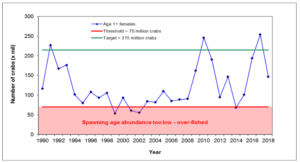Adult (age 1+) female blue crab abundance was based on results from 2017-18 Winter Dredge Survey. The 2018 spawning stock abundance was estimated at 147 million, a decrease from last year but above threshold level.

“Winter dredge survey estimate of abundance of spawning-age female blue crabs (age 1+) 1990-2018 with female-specific reference points. These are female crabs measuring greater than 60 mm across the carapace and are considered the ‘exploitable stock’ that could spawn within this year.” (Source)
Short-term management recommendations were to improve commercial catch data and estimates of recreational harvest, potentially using harvest reporting to increase accountability.
The male blue crab exploitation rate increased to 33%, slightly above the current conservation trigger (see below), prompting discussion about whether male-specific management might be warranted if exploitation of males remains at current levels. However, no immediate action or change in management strategy was recommended.

“The percentage of male crabs removed from the population each year by fishing, 1990 through 2017. Exploitation rate (proportion removed) is the number of male crabs harvested within a year divided by the male population estimate (age 0 and age 1+) at the beginning of the year calculated with the juvenile scalar.” (Source)
Critical data gaps were identified to improve blue crab management, including estimates of recruitment, influence of male abundance on the overall population, environmental factors related to recruitment variability and other sources of mortality.
For more information on blue crab research, stock assessment and funding opportunities, see NOAA Chesapeake Bay Office’s website.
